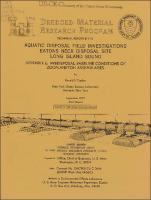Please use this identifier to cite or link to this item:
https://hdl.handle.net/11681/47206| Title: | Aquatic disposal field investigations, Eatons Neck disposal site, Long Island Sound : appendix E, predisposal baseline conditions of zooplankton assemblages |
| Authors: | Caplan, Ronald I. |
| Keywords: | Zooplankton Water quality Water--Microbiology Eatons Neck (N.Y.) Dredging spoil Dredged material |
| Publisher: | U.S. Army Engineer Waterways Experiment Station |
| Series/Report no.: | Technical Report (Dredged Material Research Program (U.S.)) ; no. D-77-6; Appendix E |
| Abstract: | A zooplankton and ichthyoplankton study was initiated in October 1974 for the purpose of establishing a baseline data bank at the Eatons Neck disposal site. A control site was also studied. During the 9-month study (October 1974 through June 1975), a total of 147 samples were taken at each of three stations (two disposal sites and one control) consisting of multi- depth tows utilizing 60-cm Bongo samplers (363 and 202 µ mesh nets). Concomitantly, temperature and salinity profiling was done. Acartia tonsa was common throughout the first 6 months of the study, with densities as high as 500,000 individuals/1000 m³ observed in March 1975. A plankton bloom occurred in populations of several copepods (including copepodids) in December 1974, e.g., Acartia clausii, Temora longicornia and Acartia spp. copepodids. Meroplanktonic Crustacea, Caridia (shrimp), and Brachyura (crabs) became abundant (greater than 100,000 individuals/1000 m³) in March and April 1975, respectively. Meroplanktonic Mollusca, Gastropoda, and Bivalvea became abundant (greater than 1000 individuals/1000 m³) in April and May 1975, respectively. There were two blooms of Cladocera during 1975, one in February (1000 individuals/1000 m³).and one in June (1,000,000 individuals/1000 m³). Evadne sp. dominated the first bloom, and Podon sp. the second. Polychaeta larvae were not common at any time during the study. The first fish eggs obtained in this study were collected in February 1975 at both control and disposal sites. They belonged to the four-bearded rockling, Enchelyopus cimbrius. Larvae of the winter flounder, Pseudopleuronectes americanus, and the sand lance, Ammodytes hexapterus, were also collected with the former being present at the control site only. The spring pattern of ichthyoplankton abundance included the eggs of Enchelyopus cimbrius, Scomber scombrus, and Scopthalmus aquosus. Myoxocephalus spp. and Pseudopleuronectes americanus larvae were also collected. The summer ichthyoplankton fauna included nine species of eggs and larvae with the first appearance of the butterfish, Peprilus triacanthus. The winter patterns of copepod abundance indicated two important findings: (a.) There was a copepod bloom in December 1974, 6 weeks before the spring diatom bloom. (b.) Copepod densities were maximum at depth during the November diurnal, indicating a reproductive strategy not previously reported. |
| Description: | Technical Report |
| Gov't Doc #: | Technical Report D-77-6; Appendix E |
| Rights: | Approved for Public Release; Distribution is Unlimited |
| URI: | https://hdl.handle.net/11681/47206 |
| Appears in Collections: | Technical Report |
Files in This Item:
| File | Description | Size | Format | |
|---|---|---|---|---|
| Technical Report D-77-6 Appendix E.pdf | 5.44 MB | Adobe PDF |  View/Open |